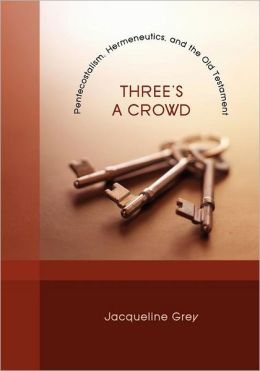Jacqueline Grey: Three’s a Crowd
 Jacqueline Grey, Three’s a Crowd: Pentecostalism, Hermeneutics, and the Old Testament (Eugene, OR: Pickwick, 2011).
Jacqueline Grey, Three’s a Crowd: Pentecostalism, Hermeneutics, and the Old Testament (Eugene, OR: Pickwick, 2011).
In this book, Jacqueline Grey makes the case for applying a distinctive Pentecostal hermeneutic to the Old Testament. The hermeneutic in question is one that (she says) had been applied successfully to the New Testament by others, but previously had not been applied to the Old Testament. By that, she seems to mean that it has not been applied in a controlled academic setting.
Grey’s hermeneutic is not so much one that she constructs on the basis of scriptural or philosophical principles, but rather one whose elements she finds in a survey of early Pentecostal history. Thus her hermeneutic is “Pentecostal” because, in a sense, it is a recovery of principles or reading habits used by early Pentecostal readers of the Bible. In Grey’s hands, of course, there is a bit of streamlining, as well as some classifying of hermeneutical principles according to current academic discussions, but by and large Grey argues the case for retaining the hermeneutic of the early Pentecostals, including its premodern elements. Unfortunately she gives little attention given to why a traditional Pentecostal approach should automatically be affirmed by Pentecostals. Surely there is always a chance that a traditional approach is wrong in some respect – I thought that was the whole reason the science of hermeneutics exists.

Rev. Jacqueline Grey is Associate Professor of Biblical Studies at Alphacrucis College in Sydney, Australia.
This was an enjoyable book, and I recommend it for anyone wanting to come up to speed with the current discussion. It contains a wealth of information about the early Pentecostal reading of Scripture (most of which I’m not qualified to judge). In the review or survey aspects of her book, Grey avoids enough of the stilted language of standard academic-style surveys to keep most readers (including non-academic ones) interested. Unfortunately, Grey has a tendency to treat the historical-critical approach unfairly, but that will not be a surprise to anyone conversant with the current trend.
The only drawbacks of this book lie in questions I have about Grey’s fundamental approach. Grey seems to assume that the early Pentecostal approach to Scripture is the correct approach, apparently because (and just because) it’s Pentecostal. This leads to other problems, in my opinion, but I will spare the reader a detailed complaint. I think that most attentive readers will find themselves asking the same question I asked: “What makes the historical Pentecostal approach the right Pentecostal approach?” In fairness, however, it is worth noting that Grey is not the only Pentecostal scholar who moves directly from the descriptive to the prescriptive.
Reviewed by John Poirier
Preview: https://books.google.com/books?id=o0tgBQAAQBAJ
Category: In Depth, Winter 2015


